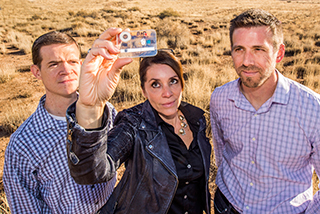Popular Science named Sandia-based anthrax detector technology one of 100 best innovations of 2015

Sandia scientists, from left, Jason Harper, Melissa Finley, and Thayne Edwards show a BaDx anthrax detector. (Photo by Randy Montoya)
Popular Science magazine has named the Sandia-developed BaDx anthrax detector as one the year’s top 100 technology innovations. It is one of nine technologies listed in the Security category of the magazine’s annual “Best of What’s New” list.
BaDx, which has been licensed by Aquila, an Albuquerque-based, woman-owned small business that specializes in the design and manufacture of technologies and services for nuclear security and international safeguards, is a credit-card-sized detector that is simple to use and inexpensive to produce.
In its description of BaDx on the “Best of What’s New” website, Popular Science editors wrote:
“Anthrax, a bacterial disease of grazing animals, can be a deadly terrorist tool. Now Sandia National Laboratories and security-technology company Aquila are making it simple to detect. They’re producing a credit-card-size lab-on-a-chip that’s akin to a pregnancy test: Inject a sample and wait a few hours for a line to appear. Because the test is portable, samples won’t accumulate in labs — which is a security risk. It will help ranchers around the world detect the disease in their livestock. Aquila, which is producing the tests in partnership with Sandia, began shipping units earlier this year and plans to adapt the technology for other bacteria like E. coli.”
BaDx needs no battery or electric power or special laboratory equipment. It’s hardy against wide temperature variation and can detect very small numbers of B. anthracis spores. A field technician puts a sample swab into the amplification chamber, which contains selective growth media. The device then uses a lateral flow assay, similar to a common pregnancy test, to detect B. anthracis. Magnetically operated valves allow the sample to advance from stage to stage to complete the testing process. A colored line appears on the device several hours later, if the test is positive for the bacteria.
The technician can then initiate a chemical process that sterilizes the device, avoiding the risk of positive samples accumulating and falling into the wrong hands.
A Laboratory Directed Research and Development (LDRD) project in Sandia’s International Biological Threat Reduction Program led to BaDx.
Melissa Finley was principal investigator of a large team that helped develop the detector. Jason Harper and Thayne Edwards developed the microfluidics platform with the patent-pending magnetic valves that move the sample through the testing process. Bioscientist Bryan Carson, with technologists Jackie Murton and Bryce Ricken, developed the selective media and worked on building and testing the device, as well as helping to develop the decontamination strategy. Nanotechnology researchers George Bachand and Amanda Carroll-Portillo are working on improved strips for the lateral flow assay. Bill Arndt, a researcher in the International Biological Threat Reduction Program, who regularly works in the developing world, provided guidance on device design.
Thayne says the recognition by Popular Science has a special meaning for him.
“As a teenager I remember reading Popular Science magazines and being wowed by science and technology so advanced it often seemed unreal. In a real way though, it helped encourage me to pursue engineering as a field of study. So I was elated to find out that something I helped to create was being recognized in Popular Science’s pool of Best of What’s New. This has reminded me of why I love engineering and science.”
In addition to its recognition by Popular Science, BaDx has won a 2015 TechConnect Innovation award, a 2015 R&D 100 award, and the Federal Laboratory Consortium’s 2015 Award for Excellence in Technology Transfer.